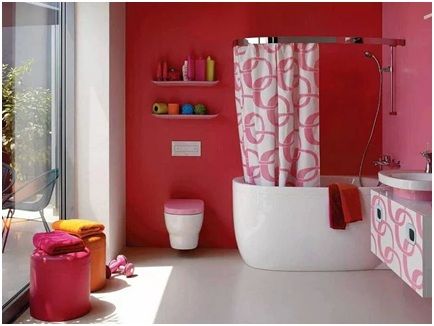Finishing material for the bathroom. Options for wall decoration in the bathroom
Wall decoration in the bathroom is carried out using various materials. Compared to other rooms, the process has its own characteristics. Finishing materials used in wet rooms, in addition to decorative indicators, also meet certain functional criteria. They allow you to operate the created cladding for many years. Tile is often used for these purposes. In addition to the tiles, the walls of the bathroom are decorated with plaster, stone, plastic panels, mosaics, moisture-proof wallpaper and film, and painted. Each option is good in its own way, and the price range is wide. This allows you to choose practical material for the budget of repair work. The following photo shows a beautifully designed room with a bathtub.
Bathroom wall decoration is designed to create a beautiful, original interior, and it should be practical. A special approach is required here in order to brightly, stylishly, inimitably and at the same time functionally design the room. A combined version of the decor is shown in the photo below.
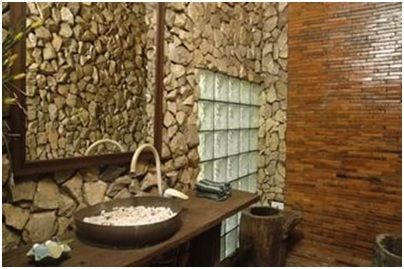
For these purposes, various types of finishes are used. New materials are gradually replacing traditional ones. When choosing what is better to finish the walls in the bathroom, it should be borne in mind that the room has its own special microclimate. Therefore, the facing coating should have the following characteristics:
- be resistant to high humidity and temperature extremes;
- do not require specific care;
- differ in environmental cleanliness and hygiene.
An important role is played by the durability and strength of the created decor. On the part of saving money, a good option for wall cladding is one that is easy to install. This allows you to perform all the work yourself.
Finishing Methods
When planning or conducting repairs, the issue of choosing a working material is relevant. There are many options for decorating the walls in the bathroom. Of these, you should choose a design method that is most appropriate for financial capabilities, aesthetic preferences, characterized by practicality.
Decorating a bathroom with ceramic tiles is a classic option that has been used for more than one century, but has not lost its relevance to this day. Tiles are also used for decorating porches, saunas, baths, floors of offices, hospitals, public institutions. The scope is very wide.
In the market it is represented by a wide range. The plates are obtained by pressing clay-based mixtures, followed by firing in special furnaces at 1200 degrees.
The tile is divided into:
- glazed, coated with a special layer;
- unglazed, without a protective coating.
The latter option has a natural texture, attractive natural look. But due to the lack of a protective layer, unglazed tiles are poorly suited for damp rooms.
Products are available in various sizes and shapes: square, rectangular, in the form of circles, ovals, hexagons, triangles. It is represented by a variety of color options and textures.
There are non-standard products with metal, mirror, or stone inserts.
Along with the tiles, manufacturers offer for decoration dividing borders.
The advantages of this finishing material are:
- high mechanical strength;
- beautiful decorative look;
- resistance to aggressive substances, fire, the influence of temperature changes, high humidity;
- easily combined with other materials used to decorate the walls of the bathroom;
- environmental friendliness, hygiene;
- maintainability, ease of maintenance.
The tile in the interior is shown in the photo below.

The traditional disadvantage is the complexity of installation, which requires careful preparation of the walls of the bathroom.
For repair, you can either choose the tiles yourself, or use ready-made collections from manufacturers. The price range is extensive: from budget options to luxury ones. That makes it possible to choose the best tile for wall covering.
Plastering
Plastering is another common way of decorating walls in a bathroom. It is a mixture of a binder, fillers, additives. By production, both natural and artificial ingredients are used.
The basis of the compositions can be cement-sand or gypsum.
The most common fillers are:
- polymer granules;
- cellulose fibers;
- stone crumb;
- glass.
Plastering allows you to both make a smooth coating, and embossed. The addition of pigments contributes to a wide variety of colors and shades. An example of how to finish the Venetian, is presented further in the photograph.
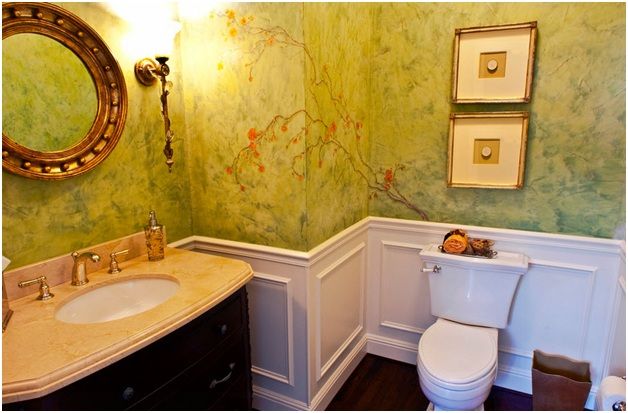
The advantages of the created finish are:
- plaster allows you to cover with a whole (continuous) layer without seams the entire decorated work surface;
- perfectly combined with similar materials;
- resistance to various influences, long service life, easy maintenance;
- the foundation does not require special preparation.
When using plaster, there is the possibility of cracking. This is especially true for new buildings whose shrinkage has not been completed.
When choosing plaster, waterproof mixes are preferred. For wet rooms, facade options that are based on polymers, epoxies are well suited.
Wall painting
The walls of the bathroom are often painted. This is due to the large selection of compounds in the construction market. Paints for incoming substances are divided into several types. They are presented further in the table. Also there are their main characteristics.
| № | View | Description |
|---|---|---|
| 1 | acrylic | the basis of the composition is acrylic polymer, additives are marble chips, titanium dioxide |
| 2 | latex | resistant to detergents, moisture |
| 3 | silicone | it can be applied to various types of substrates: concrete, brick, plastered |
| 4 | silicate | this paint, resistant to moisture and temperature, is made of water glass with the addition of resin, silicon, metal oxides (for different colors) |
The silicone version combines the advantages of latex and acrylic compounds.
Interior decoration with paint is shown in the photo below.
During the repair, walls, ceilings are painted with paint. It can be combined with its other varieties or finishes. This is the most affordable way of registration. The undoubted advantage of decoration is the ability to do it yourself. Durability, aesthetics of the coating depend not only on the quality of the material, but also on the skill of applying paint.
Decoration with plastic panels, plasterboard lining
Plastic is another material for wall decoration in the bathroom. They can completely cover the entire room. Products are made from polyvinyl chloride, which in the normal state does not pose a health hazard.
There are ceiling and wall varieties of plastic panels. The differences are strength, flexibility, thickness of the material.
Laminated panels - a good option for the bathroom than you can finish the walls. They are characterized by increased resistance to various influences due to the presence of a special protective layer (film).
The advantages of plastic are as follows:
- wide range of products;
- ease of maintenance;
- allows you to hide communications: sewage pipes, water supply, heating system;
- simpler installation compared to materials used for similar purposes;
- the base does not need to be prepared perfectly.
But the material has some disadvantages:
- impervious to steam;
- less resistant to mechanical stress than tile;
- during installation, the volume of the room is reduced.
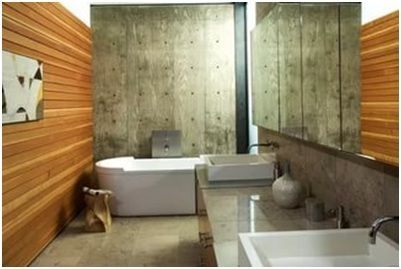
The photo above shows a plastic coating option.
Quite often, when replanning and the need to align curved surfaces, the question arises: from what can walls be made in the bathroom? One option is to use moisture-proof drywall for these purposes.
This material allows you to build internal walls, insulate and soundproof the room. When decorating, drywall is pasted over with tiles, wallpaper, painted, sheathed with plastic panels.
Giprock is easy to install and cheap, but with a small area of \u200b\u200bthe rooms, their volume will decrease even more.
Plastic is one of the cheapest ways to create decor and additional protection for the base. In order not to bother with uneven walls for a long time, panels and waterproof gypsum board - this is what it is better to choose from .
Mosaic
Mosaic is a magnificent, bright coating that can be created from small fragments of ceramics, glass, stone, smalt, metal.
The options for wall decoration in the bathroom in color, size and shape of the elements are very different.
Coverage is made in two ways:
- sticking individual pieces manually;
- using ready-made options.

The first case is a painstaking, laborious process, time-consuming. But at the same time an exclusive result is achieved.
The second way to decorate is much faster and easier.
In the market mosaic on the basis of plastic is on sale. It is fixed easily, special skills are not required from the worker.
In addition to a spectacular appearance, the mosaic is characterized by such positive characteristics:
- mechanical strength, long service life;
- excellent hygienic properties;
- created coating has no joints.
The disadvantages depend on the material used to create the mosaic. The coating itself and its installation are expensive.
Mosaic is a beautiful, practical, but expensive design option. Only professionals can handle it in pieces. Panels will be able to mount and less experienced people.
Wallpapering and special film
If there is a question about how to glue the walls in the bathroom, then for these purposes you can use wallpaper or a self-adhesive film.
Paper options for paintings disappear immediately. A suitable option is vinyl or glass. When using the first, the benefits are as follows:
- relatively low price of the material, but more expensive than staining;
- magnificent decorative appearance and a huge variety of product range;
- wallpapering can be done independently.
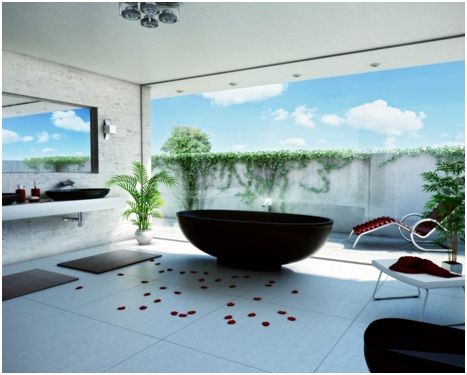
Despite the water resistance of vinyl varieties of products, moisture eventually penetrates at the joints, which makes the coating unusable. Photowall-paper allows to create beautiful design. The photograph below shows a possible outcome of their use.
Fiberglass is a more suitable option than you can paste on the walls in the bathroom. This durable material is not afraid of damp, mold, protects the base. But the price is higher than that of vinyl counterparts.
Self-adhesive is made on the basis of polyvinyl chloride. On the front side contains a decorative design, and on the back - a layer of glue covered with paper.
Produce different film options:
- matte;
- glossy;
- with 3d effect;
- sLR
- plain or with drawings;
- copying the texture of fabric, wood, tiles, mosaics, cork and other materials.
They are able to serve for at least 5 years, durable, easy to stick. It is also very easy to care for the coating. The film has a fairly good waterproofing ability, which helps to protect the base.
A significant drawback is the sensitivity to elevated temperatures. Poor quality products can stretch.
Wallpaper and self-adhesive film allow you to quickly decorate the bathroom without significant cost. Before work, flaws in the surface of the base should be well sealed.
Finishing with natural and artificial stone, wood
For the design of wet rooms, natural (marble, granite and others) and artificial types of stone are used. But this method due to the high cost has not received significant distribution. It is also required to hire a specialist to create the cladding. The material has a large weight, which imposes special requirements for its installation.
In addition to these disadvantages, the coating has excellent practical characteristics. Operate it for many decades, without any changes.
An artificial analogue of natural stone is similar in properties, but cheaper in price.

Also, decorating the bathroom with wood is a good choice. But this is an expensive way. Wood must first be treated with special solutions: flame retardants, antiseptics, antiseptic compounds, varnishes, paints.
Design using wood requires a combination of all interior elements. Harmonious cladding with boards is presented in the photo below.
Stone and wood are expensive ways to decorate. They require the involvement of specialists. But the result can exceed its wildest expectations with its appearance and practicality.
Alternative design options
Materials for wall decoration in the bathroom of a new generation are constantly appearing. One of these is agglomerate. It resembles tiles, but more durable and resistant to abrasion. Plates are easy to stack. However, the material has a high cost.
There is decoration with the following materials:
- linoleum;
- glass;
- mirrors.
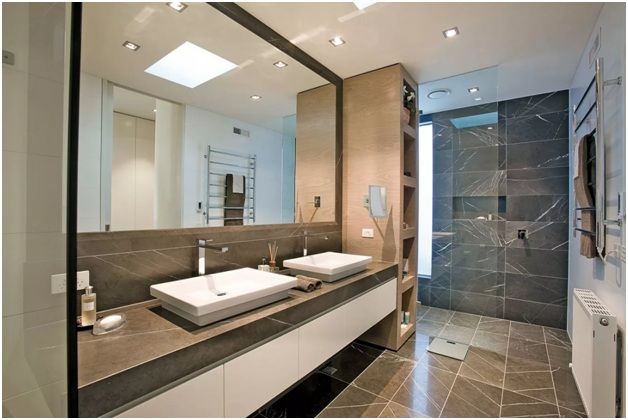
Finishing using various materials is shown in the photo below.
For design, various materials that meet operational requirements are suitable.
Materials for wall cladding in the bathroom are very diverse. With the correct installation of each of them you can get a great result. Nevertheless, the decisive factor in the choice should be the compliance of the created coating with the conditions inside the room to be designed. The most budget option is staining. This is followed by wallpaper, film and plastic panels. Other methods require large investments.
The most popular materials for decorating a bathroom are discussed in the video below.
An alternative finish with quartz vinyl is shown in the next video.
Combination allows you to get a unique look. Savings are achieved by doing the work yourself. What also spurs creative activity, develops building skills.
It is known that the bathroom belongs to a special type of room, in which a high level of humidity prevails, sudden changes in temperature and abundant steam. For this reason, bathroom finishing materials are selected according to special, overstated requirements, which include resistance to moisture, ease of maintenance and counteraction to alkaline components of detergents.
Today, there are a huge number of different materials for decoration, ranging from the simplest and not expensive, ending with exquisite works of art that require a professional approach and are much more expensive than budget materials for bathrooms.
Inexpensive finishing materials
Many people, because of their low income, cannot afford to buy expensive and high-quality materials for the bathroom, and for this reason they use cheaper finishing methods. It is possible to achieve budget savings by independently carrying out all the work without involving outside experts.
Do-it-yourself, low-cost finishes include:
- the use of waterproof paints and varnishes;
- the use of moisture-resistant wallpaper coating;
- pasting of a decorative film;
- the use of drywall;
- decorative putty or plaster.
The use of these funds can also significantly ennoble the room with proper use and compliance with technology.
When choosing a material for decorating a bathroom from the proposed list, it is necessary to take into account its characteristics, service life and application technology. Using paints and varnishes, it is necessary to use only washable substances and to ensure a perfectly smooth surface before applying them. When using waterproof wallpapers, it is necessary to cover them with special protective varnishes, which will increase their service life.
The use of a self-adhesive decorative film also requires a flat surface and certain skills in the work. During pasting, it is necessary to ensure that no air bubbles form, since they affect the life of the material. The best material for a bath from the budget series is considered to be moisture-resistant drywall, since it allows you to perfectly level the surface and hide the plumbing. It will be a good base for painting or tiling.
Budget finishing materials allow you to quickly and relatively inexpensively bring the room into normal form, but their service life is very short with the active use of the room, a new repair will be required after 2-3 years.
Medium and high cost materials
Modern materials for a bathroom from an average or high price category are used much more often, because they have a long service life and look much more solid than budget ones. Such materials include:
- tiled materials;
- natural or artificial stone;
- natural wood;
- high strength plastic;
- plaster.
All of the listed finishing materials for the bathroom can be used both individually and in various combinations with each other.
Tiled materials

Tiled moisture-proof materials for the bathroom are considered to be the most common option for decoration of rooms, since they differ in long service life and a large assortment on building shelves. Such materials include:
- ceramic tile;
- mosaic made of stone or glass;
- porcelain tile;
- agglomerate.
If you still don’t know which one, then tile will be the best and practical solution. Finishing the walls of the room with tiles is a rather complicated process that requires patience and certain skills. However, with the instructions and the necessary tools, everyone can use the tiles on their own.
Ceramic tile can be used only in places of direct contact of the surface with water, the rest of the room can be decorated with moisture-resistant wallpaper or decorative plaster.
Materials such as tiles and mosaics make it possible to create a unique design. Mosaic made of natural stone or glass is usually used for decorative inserts or as a room divider into zones, but can also be used to decorate the entire room. Working with mosaics requires a lot of patience and a high level of skill. Mirror inserts with conventional tiles are widely used to visually enlarge a bathroom and spread light from lighting fixtures.
Tile mosaics are ideal materials for smooth transitions from one color to another, as well as for decorating uneven surfaces and creating abstract patterns.
A good alternative to tiles is agglomerate. This material is characterized by higher strength and elasticity. Experienced craftsmen create rounded surfaces from agglomerate, since under the influence of high temperature it becomes elastic and can take any shape. However, its cost is an order of magnitude higher than that of ordinary tiles.
It is not difficult to find the ideal moisture-proof coating for the bathroom when arranging the floor, for this, porcelain stoneware is used. The material is extremely durable and has increased wear resistance, and also has a long service life and ease of installation.
Artificial and natural stone
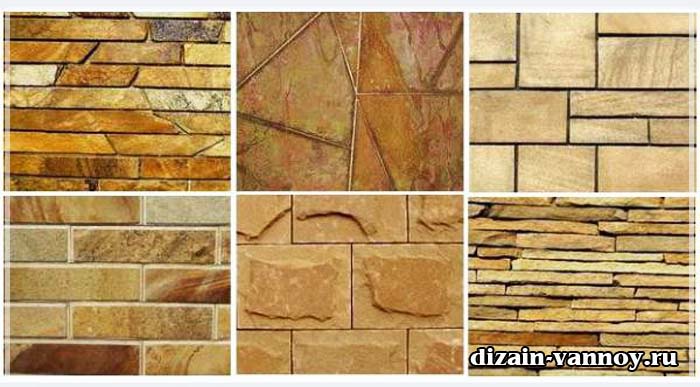
Artificial and natural stone refers to expensive materials, but their use will give the room a chic look. When laying a stone, it is recommended to seek help from qualified specialists or to thoroughly study the technology of its installation yourself. Natural facing material for the bathroom requires careful preliminary planning and the use of only high-quality tools and adhesives.
Stone products include:
- granite;
- marble;
- sandstone;
- acrylic stone;
- gypsum stone.
Choosing the best, it is necessary to carefully plan the compatibility of the stone with other materials and to think through the details of the overall design with all the elements of the interior.
It is important to remember that natural stones do not tolerate the effects of chemical detergents and alkalis, so it is recommended to think about the use of protective impregnations and varnishes to preserve the original appearance of the product. Acrylic stones are often used materials for decorating bathrooms, which are mainly used for decorating furniture, countertops and interior elements, as it is very durable and not afraid of chemicals.
Natural wood
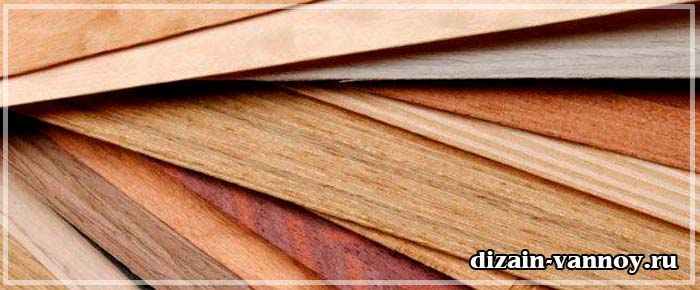
Some people think that wooden bathroom liners are unacceptable due to the large amount of moisture, but this is an erroneous opinion. Natural wood fits perfectly into the interior and allows you to make chic compositions if it is pre-treated with special moisture-resistant impregnations and antiseptics that give the material additional properties. A decorative coating for a bathroom made of wood is very common and usually in the form of laminated panels or cork wallpaper. To create panels using hardwood, such as:
- linden;
- aspen;
An advantage and at the same time a drawback is the need to create a special supporting frame, which slightly reduces the area of \u200b\u200bthe room, but at the same time makes it possible to hide wiring or plumbing elements. Finishing materials for bathrooms can be made from softwood, but they are mainly used for steam rooms.
Plastic
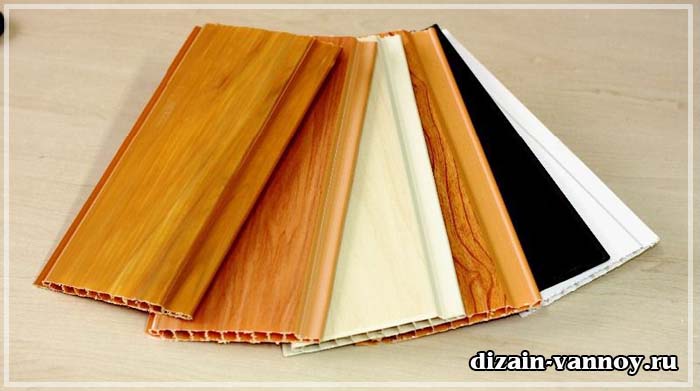
Plastic panels or “siding” are actively used for decorating walls and ceilings of a room. The panels can be attached to the surface with adhesives or on a special frame. Such materials for bathroom lining have a huge number of shapes, colors and textures. The vast majority of manufacturers are trying to imitate the texture of natural wood or natural stone, and sometimes it is done so high quality that at first glance it is difficult to notice the difference.
Plastic materials for the bathroom have gained popularity due to their low cost, ease of installation and ease of maintenance. They are widely used to create boxes or niches in which bath accessories or communications are hidden. They were also widely used in the ceiling lining, as the material tolerates temperature extremes and moisture.
If you still decide what material to decorate the bathroom so that it is beautiful, fast and not expensive, then PVC panels will be the best option.
Plaster
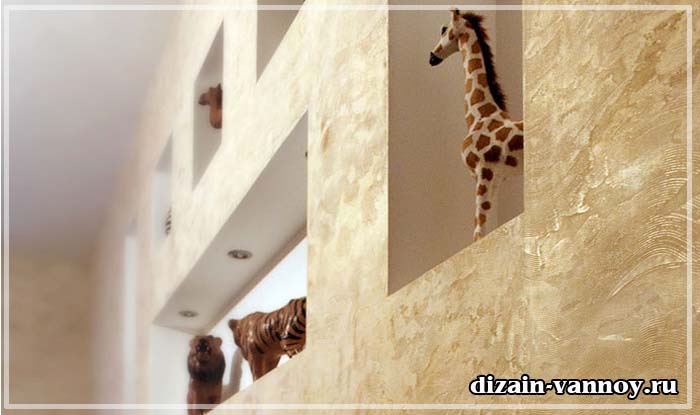
Not less demanded material for wall decoration is plaster in all its forms. Especially popular decorative plasterwith the help of which unique textured coatings are created. Before you can decorate a bathroom with such material, it is worth remembering the need to attract qualified workers, since it is most likely impossible to create a beautiful coating on your own, without having certain skills.
Decorative plaster may contain various fillers, such as sawdust, cotton fibers or marble chips. A huge assortment of different types of this material allows you to create a texture in the form of stone, silk fabric, wood, jammed paper or even imitate a metal coating. These materials for repairing the bathroom and its decoration are among the expensive products and are usually used in spacious rooms.
The choice of materials is influenced not only by their cost, but also by the area of \u200b\u200bthe decorated room, since not all of the listed products can be harmoniously applied in small and cramped rooms. What material is best for the bathroom in your case, you can determine yourself after reading the article.
Types of wall decoration in the bathroom
A feature of the climate of bathrooms is the presence of an increased level of humidity and temperature differences. This places particular demands on the wall covering material, which must be moisture resistant, easy to maintain, and no harmful fumes in high temperature conditions.
Wall decoration in the bathroom involves a selection of many materials.
There are a number of commonly used coatings that decorate the walls of the bathroom. The entire range, suitable for covering the walls of bathrooms, has pros and cons when choosing a price category, installation and operation.
Most commonly used:
- ceramic tile;
- porcelain tile;
- plastic panels;
- self-adhesive film;
- wallpaper;
- waterproof paint.
To the question of how to decorate the walls in the bathroom, everyone is looking for an answer individually, based on their own ideas of the type of room and priorities in the materials.
Ceramic tile
Tiles for many years remain a favorite among other finishes due to the properties of durability, environmental friendliness, resistance to moisture and aggressive environments. Creates a unique design of the premises due to the variety of textures and colors.
The disadvantages of tiles include the complexity of laying, to create a high-quality surface, you must have skills. The most difficult is to lay out a row using part of the tile according to the required size.
Styling Features:
- A careful calculation of the required amount, taking into account a possible battle or marriage. Buying the missing number is difficult due to differences in color shades of different parties.
- Absolute readiness to work before starting to conduct a continuous process of a single perimeter of the area.
- Installation layout marking with chalk.
- Compliance with the necessary requirements of smooth surfaces, with a deviation of a level exceeding 4-5 mm per 1 square meter, is used to smooth the surface of the plaster.
- Soaking ceramics before laying.
- The use of mounting crosses for cross-gaps.
- The use of mastic or special glue as a binder.
Tip: When buying, you need to choose a tile with a sign indicating resistance to reagents. If it is necessary to expand the visual space, the choice is stopped on a large tile.
Porcelain Tiles
New high-strength material, has the qualities of wear resistance, lack of reaction to detergents, aggressive environments, moisture, which can withstand high temperatures.
Durability consistent natural stones. The use of porcelain tiles allows you to finish the walls and floor with one material due to its strength.
The disadvantages of the material include the complexity of laying, low thermal conductivity and the high price of the material.
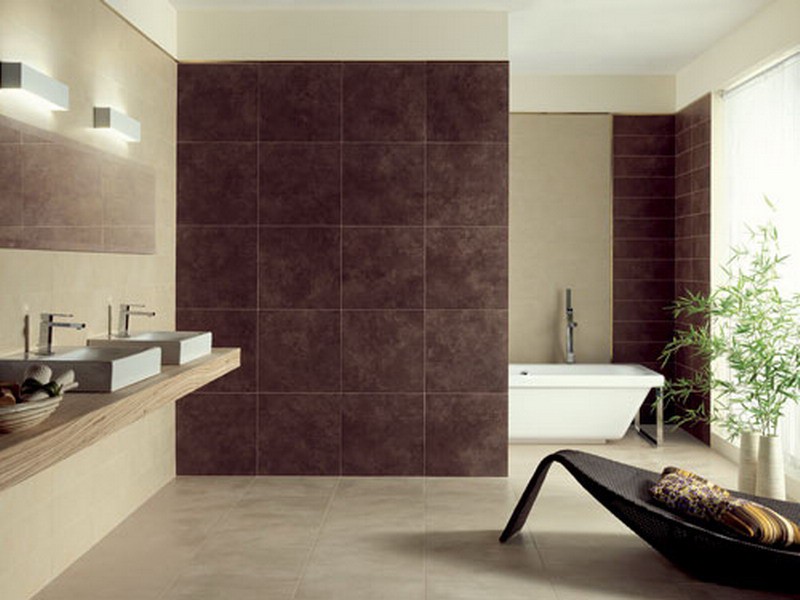
Tip: Particular attention should be paid to the selection of glue for porcelain stoneware and due attention should be paid to studying the instructions for use.
Plastic panels
Wall-mounted plastic panels quite often finish the walls in the bathroom. They are characterized by ease of installation, in which there is no need to level the surfaces.
The time for finishing the whole bathroom takes no more than a day. Repair work is not accompanied by dust and dirt, as is the case with tile laying.
It has the properties of resistance to temperature fluctuations, water. Easy to clean.
Does not lose appearance. Fairly low-budget finish.
Installation Nuances:
- The panels are attached to a wooden crate attached to the wall. Pre-wooden parts are treated with stain, the walls are treated with an antifungal solution.
It is possible to use plastic bars of the lathing as an alternative to wood, amenable to decay in a humid environment. - Joints of panels must be lubricated with sealant or other insulating compound to prevent water from entering under the panels.
- Strong heating of the panels is advisable to avoid, a heated towel rail and the surface of the plastic should be ten centimeters behind each other.
Tip: When decorating the walls of new buildings, it is better to use wall plastic panels that have advantages over ceramic tiles for houses that will shrink.
Self-adhesive film
Easy way to protect the walls. The film is distinguished by its resistance to moisture, ease of gluing and low cost.
A variety of colors allows you to choose an imitation for natural materials, such as wood. A layer of antifungal agent must be applied under the self-adhesive film.
When gluing, glue is additionally used, the joints are coated with sealant.
The disadvantage of self-adhesive film is the fragility and the inability to apply it to the place of direct contact with water. Suitable for combination finishes in conjunction with other materials, such as panels.
Tip: When buying, you need to choose a film with a smooth surface, which will make it possible to simplify the care of the coating.
Wallpaper
The advantage of using it is the ability to frequently change the wallpaper to update the interior. You can use vinyl wallpaper, silk screen printing.
When buying, you need to look for the “brush” icon on the package, which indicates the possibility of wet cleaning. The glue is used special, not swelling under the influence of moisture, suitable for vinyl wallpaper.
All joints are additionally treated with PVA glue.
- The downside of the finish is the property of the wallpaper to change shape under the influence of temperature changes. That is why the bathroom, the wall decoration of which is covered with wallpaper, is rare.
- An option, also rarely used, is the application of liquid wallpaper on the wall. This is a type of plaster that has a water base.
It is applied to a deeply penetrating primer to improve adhesion. The base is allowed to dry, at the time of laying the liquid wallpaper, the wall should be dry.
The surface is coated with a colorless varnish to increase the water-repellent property. Repair work is difficult to carry out, to obtain information you must first preview the video on the Internet - networks or seek help from a specialist.
Tip: You need to buy vinyl wallpaper for the bathroom with the manufacturer's marks on the implementation of a certain anti-fungicidal treatment that prevents the formation of mold and fungi. If you want to decorate the bathroom with wallpaper, it is better to apply a liquid type.
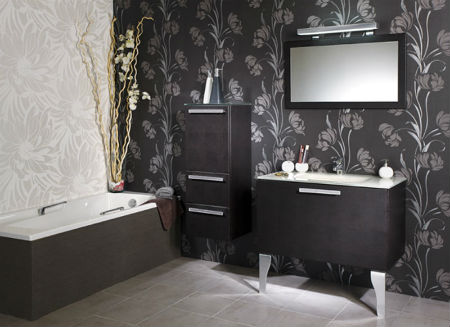
Waterproof paint
Paint as a decoration for bathrooms has been used for a long time, appreciated for its durability, environmental friendliness, the possibility of unimpeded updating of the coating, low cost. The paint is used waterproof water-based acrylic or latex.
The work does not differ in complexity, they can be done with your own hands, but they require a certain awareness of the process for the employee. Before starting the decoration, it is advisable to familiarize yourself with the photo of the painting.
Painting Details:
- The surface must be pre-cleaned, chalk coatings washed off to a concrete base. An antimicrobial agent is applied to prevent the spread of the fungus.
- A moisture resistant primer is laid under the paint layer, several passes are made. Each time the surface must be allowed to dry before applying the next coat.
- The surface on which the paint is applied must be dry. How to paint can be read on the can, which is accompanied by detailed instructions.
- Wear-resistant coating can only be obtained by applying paint in several layers.
Tip: It is undesirable to use oil paints that are not used due to the rapid loss of properties in humid air with temperature fluctuations.
All listed types of design of bathrooms are used often. When choosing the most suitable coating, the dimensions of the room, the minimum level of humidity, and the price of finishing are evaluated.
Sometimes a successful design decision is a combination of materials, during the implementation of which attention is paid to joints for which additional processing with adhesives or sealant is performed.
Much less often, alternative methods of solving interior decoration in the bathroom are used. It is decorated with mosaics, glass blocks, wood, laminate, wall painting by an artist - decorator.
Any repair gives a flight for imagination, realizing which, you can get a unique bathroom decoration.

